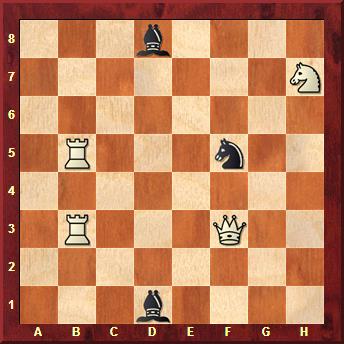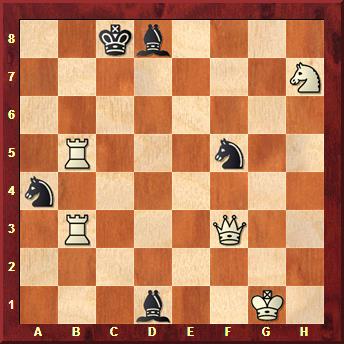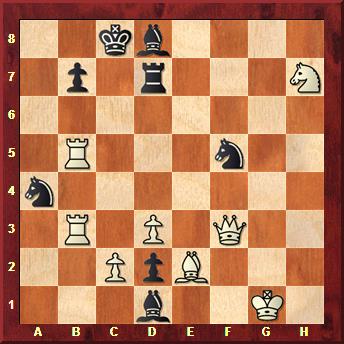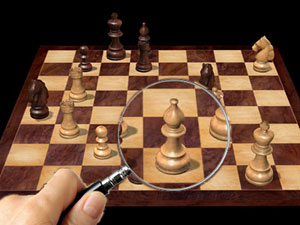Introducing Recompositions: An exercise in forensic chess
By Azlan Iqbal, Ph.D.
In the process of programming Chesthetica to compose chess problems for
my YouTube
channel, I came across an interesting problem. Sometimes, debugging
involves working backwards. In this case, I am referring to figuring out
or "recomposing" what the original starting position of a chess
problem was when all you have to work with are bits and pieces of information,
such as a line or variation played from that position. The starting position
(e.g. FEN) was not recorded since the error occurred in the middle of the
composing process. I will show you one example. These are the moves from
a particular mysterious starting position (yes, in coordinate notation,
as it were) and I wanted to know what the initial position looked like.
1. h7g5 d8g5
2. b5d5 d1c2
3. b3a3 f5h4
4. f3e4 g5e7
5. e4f4 e7a3
6. d5b5 a3d6
7. f4g5 a4c3
8. g5h4 c3b5
9. h4g5 d6e5
10. g5g6 c2d3
My thought process went as follows. White’s first move is from h7
to g5, so there must have been a white knight on h7. It simply cannot be
any other way due to the uniqueness of the knight movement. This is followed
by Black playing d8 to g5, so the d8 square could have been occupied by
a black bishop or a queen, the only possible long-range pieces. I decided
to try with a bishop for the moment. White then plays b5 to d5, which means
it could be a rook or a queen. I decided to try with a rook. Black then
plays d1 to c2, which means the piece on d1 could be a bishop, queen or
even the king. I settled on a bishop, for the moment. Besides, there is
already an opposite-colored one on d8, so it seems plausible. The position
thus far looks like this.

Then White plays b3 to a3, which means the piece on b3 could be a rook,
queen or even the king; but not the king, actually, because that would make
the first move illegal given that there is a black bishop on d1 which puts
the white king in check. So I tried with a rook. It makes sense White might
have doubled rooks on the b-file. Black responds with f5 to h4, and that
means there must be a black knight on f5. White plays f3 to e4, which means
it could be a pawn capture, a bishop, a queen (possibly more than one on
the board) or even the king. Yet again, it can't be the white king because
of the black bishop on d1. So I tried with a pawn. Never mind for the moment
what it captures on e4. Black responds with g5 to e7 and from move 1 we
know a black bishop captured the knight on g5. White then plays e4 to f4,
so that means f3 cannot be a pawn. It must be a queen, en prise to the bishop
on d1, as it were. The position now looks like this.

Black then plays e7 to a3, with that same black bishop from move 4; but
we also know this is a capturing move because of White’s rook move
from b3 to a3 earlier (move 3). White continues with d5 to b5, using the
same rook from move 2. Black replies a3 to d6 with the bishop that just
captured the rook. White plays f4 to g5 with his queen which was on f4 from
move 5. Black plays a4 to c3, which means a black knight must be on a4.
White plays g5 to h4 with his queen that was on g5 from move 7. This move,
as we now know, captures the black knight that moved to h4 on move 3. Black
responds with c3 to b5, capturing the white rook. White continues with h4
to g5, the queen shuffling back. Black replies with d6 to e5. White plays
g5 to g6, with the queen moving just one square yet again (she was on g5
last, remember?) Black ends the sequence with c2 to d3, where his bishop
was. The position now looks like this.

Obviously, we are not done because the kings are missing! It's sensible
to put them in places where they are not in check. Let us start with the
white king. Where would he be? There are many possibilities, but I went
with something safe and placed him at g1. The black king, I decided on c8.
This is the tentative starting position.

Now it is time to try the moves to see if they make sense!
1. h7g5 d8g5
White’s first move does not seem to make much sense but it may have
been a positional sacrifice given he is heavily up in material. Black captures
the knight, which makes perfect sense. More importantly, White’s queen
is en prise to the bishop on d1, so there is likely a white pawn on e2,
which we should add. But wait. White’s rook on b3 is also en prise
to the same bishop. Should we add a white pawn on c2 as well? We can’t
do that because then it would be illogical how the black bishop arrived
on d1. So why not replace the pawn on e2 with a white bishop and put a white
pawn on c2?

2. b5d5 d1c2
3. b3a3 f5h4
Plausible enough.
4. f3e4 g5e7
White’s move here does not make much sense because the queen is put
en prise to the bishop on c2. We need another blockade... perhaps in the
shape of a white pawn on d3?

5. e4f4 e7a3
6. d5b5 a3d6
7. f4g5 a4c3
8. g5h4 c3b5
9. h4g5 d6e5
Still plausible given that d6 to e5 could be a positional sacrifice of
some kind.
10. g5g6 c2d3
It is unlikely Black would just sacrifice a bishop with c2 to d3, so it
must have been defended by a pawn on say, c4. But that would mean in the
initial position, the white rook on b3 is en prise. So more likely the bishop
is defended by another piece. How about a rook on d7? But even that does
not make sense because the exchange is still unfavorable. Unless... there
is a black pawn on d2, about to queen if the white bishop on e2 moves away!
So the starting position now looks like this.

The problem is, this is now a mate in two with 1. Qc6+, but a black pawn
on b7 can fix that. Below is the final ‘recomposed’ starting
position given the move sequence above.

So it works but is probably not 100% correct. Does your detective work
lead you to a different starting position? Here's the above position in
ASCII and FEN, for you to experiment with:
wKg1,Qf3,Nh7,Be2,Rb3,b5,Pc2,d3/bKc8,Na4,f5,Bd1,d8,Rd7,Pb7,d2
2kb4/1p1r3N/8/1R3n2/n7/1R1P1Q2/2PpB3/3b2K1 w - - 0 1
Clearly, given more variations or other pieces of information, the starting
position can more accurately be guessed and proven, to an extent. Unfortunately,
in this particular case, I do not have the actual starting position that
fits the moves above to compare against. Except that I do have one more
thing... an engine evaluation of the provided line above showing +8 (pawns),
which means the final position is probably more wrong than it is right.
Here is what we got playing through the moves with an engine running:

[Event "ChessBase.com article"] [Site "?"] [Date "2015.10.27"] [Round
"?"] [White "Iqbal, Azlan"] [Black "Recomposition"] [Result "*"] [SetUp
"1"] [FEN "2kb4/1p1r3N/8/1R3n2/n7/1R1P1Q2/2PpB3/3b2K1 w - - 0 1"] [PlyCount
"20"] {Reconstruction from the move sequence: 1. h7g5 d8g5 2. b5d5 d1c2
3. b3a3 f5h4 4. f3e4 g5e7 5. e4f4 e7a3 6. d5b5 a3d6 7. f4g5 a4c3 8. g5h4
c3b5 9. h4g5 d6e5 10. g5g6 c2d3} 1. Ng5 Bxg5 2. Rd5 Bxc2 (2... Bxe2 {
and Black wins.}) 3. Ra3 (3. Rxd7 {leads to a forced mate.}) 3... Nh4
(3... Be3+ {draws.}) 4. Qe4 (4. Qh3 {is a far more compelling move.})
4... Be7 5. Qf4 (5. Qe6) 5... Bxa3 6. Rb5 {is a draw.} (6. Rxd7 Kxd7 7.
Qxd2 {wins.}) 6... Bd6 {loses.} (6... d1=Q+ 7. Bxd1 Bxd1 8. Qxh4 Bc5+
{is a draw.}) 7. Qg5 $2 {loses for White.} Nc3 {is a draw.} (7... Bxd3
8. Bg4 d1=Q+ 9. Bxd1 Bxb5 10. Qxb5 Bc5+ 11. Kh2 Rxd1 12. Qxa4 Rd2+ {probably
wins for Black.}) 8. Qxh4 Nxb5 (8... Nxe2+ {leads to a forced mate for
Black.}) 9. Qg5 (9. Qc4+ {is a better attempt to save the game.}) 9...
Be5 {draws.} (9... Bxd3 {wins.}) 10. Qg6 $2 {loses.} (10. Qxe5 {draws.})
10... Bxd3 $2 {draws.} (10... Rg7 {forces mate.}) *
So: the actual starting position in this case might remain a mystery indefinitely,
unless – unless one of our readers can work it out. There is a special
prize for the best and most plausible position submitted: an historic copy
of Fritz 13, signed by the 13th World Champion Garry Kasparov, who visited
Malaysia last year. You can send your solutions to my
official email address with a c.c. to my
private address, just in case our spam filter here at the university
gets too fussy.

I have two more copies of Fritz 13 signed by
Garry Kasparov. If there are multiple
valid and interesting entries I am willing to nominate multiple prize winners.
Previous ChessBase articles by Prof. Azlan Iqbal
-
5/31/2015 – Celebrating
300 machine generated problems
As we reported before, Chesthetica, a program by Azlan Iqbal, is autonomously
generating mate in three problems by the hundreds, and the author is
posting his selections in a very pleasing format on YouTube. The technology
behind the program’s creativity is a new AI approach and Dr. Iqbal
is looking for a substantial research grant for applications in other
fields.
- 4/7/2015 – Switch-Side
Chain-Chess Revisited
The search continues for a chess variant which retains the flavour of
the original game but does not succumb to the brute calculating power
of modern computers. AI researcher Azlan Iqbal has proposed his own unique
variant. Now he provides some test games and shows how Carlsen could have
won (instead of lost) WCCh Game 3 against Anand in Sochi had Switch-Side
rules applied.
-
2/6/2015 – Computer
generated chess problems for everyone
Now they are composing problems that fulfil basic aesthetic criteria!
Chesthetica, a program written by Azlan Iqbal, is churning out mate
in three constructs by the hundreds, and the author is posting them
in a very pleasing format on Youtube. How long will Chesthetica theoretically
be able to generate new three-movers? Quite possibly for tens of thousands
of years.
-
11/7/2014 – A
machine that composes chess problems
Chess problems are an art – positions and solutions, pleasing
to the mind and satisfying high aesthetic standards. Only humans can
compose real chess problems; computers will never understand true beauty.
Really? Dr Azlan Iqbal, an expert on automatic aesthetic evaluation,
imbued his software with enough creativity to generate problems indefinitely.
The results are quite startling.
-
7/26/2014 – Best
‘Chess Constructs’ by ChessBase readers
Chess constructs are basically an intermediate form of composition or
chess problem, lying somewhere between brilliancies from chess history
– and artistic chess problems, between real game sequences and
traditional award-winning compositions. A month ago Dr Azlan Iqbal explained
the concept asked our readers to submit compositions of their own. Here
are the winners.
-
6/29/2014 – Azlan
Iqbal: Introducing ‘Chess Constructs’
People love brilliancies from chess history – and artistic chess
problems. But there is a big gap between the two. Positions from games
demonstrate the natural beauty of actual play, while chess problems
are highly technical, with little practical relevance. The author of
this interesting article suggest an intermediate form, one you can try
your hand at – and win a prize in the process.
-
9/2/2009 – Can
computers be made to appreciate beauty?
Or at least to identify and retrieve positions that human beings consider
beautiful? While computers may be able to play at top GM level, they
are not able to tell a beautiful combination from a bland one. This
has left a research gap which Dr Mohammed Azlan Mohamed Iqbal, working
at Universiti Tenaga Nasional, Malaysia, has tried to close. Here's
his delightfully interesting PhD thesis.
-
12/15/2012 – A
computer program to identify beauty in problems and studies
Computers today can play chess at the grandmaster level, but cannot
tell a beautiful combination from a bland one. In this research, which
has been on-going for seven years, the authors of this remarkable article
show that a computer can indeed be programmed to recognize and evaluate
beauty or aesthetics, at least in three-move mate problems and more
recently endgame studies. Fascinating.
-
2/2/2014 – A
new, challenging chess variant
Ever since desktop computers can play at its highest levels and beat
practically all humans, the interest of the Artificial Intelligence
community in this game has been sagging. That concerns Dr Azlan Iqbal,
a senior lecturer with a PhD in AI, who has created a variant of the
game that is designed to rekindle the interest of computer scientists
– and be enjoyable to humans as well: Switch-Side Chain-Chess.
- 5/11/2014 – Kasparov
in Malaysia
He was mobbed, but in a good way: a large number of chess fans and autograph
hunters sought close contact to the legendary World Champion, who officiated
the opening of the PMB National Age Group Championship 2014, and took
time to discuss a variety of topics with an expert on aesthetics-recognition
technology in chess, our author Dr Azlan Iqbal – who sent us a big
pictorial report.

































